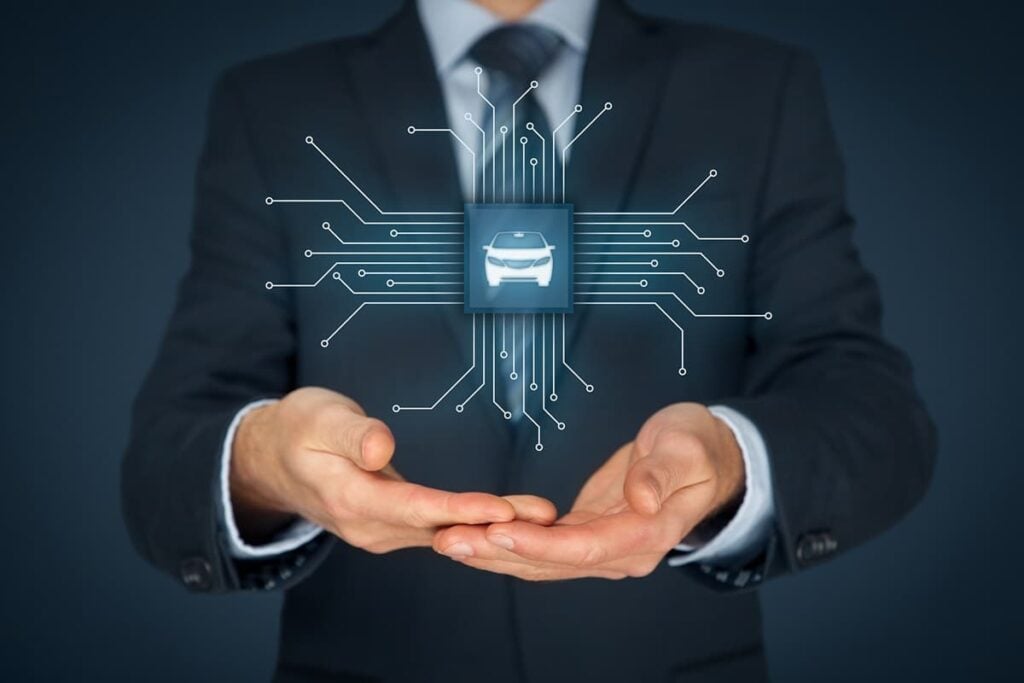Autonomous Vehicles are (Kind Of, Sort Of) Finally Here
Table of contents

Being a retail investor in technology stocks is a Catch-22. On one hand, as an investor in it for the long game, you have to be patient and disciplined. On the other, as someone ready to jump into a flying car for a road trip to Mars, technological progress seems agonizingly slow, especially when you’re in the thick of it. We’ve been checking our watch every five years for signs when futuristic tech like fusion power or graphene will scale commercially. Another hurry-up-and-wait tech industry, autonomous driving, falls into the same category. Or does it?
A Very Brief History of Self-Driving Cars
We’re equivocating for a couple of reasons. First of all, self-driving vehicles have actually been around (kind of, sort of) for more than a century. Dubbed phantom autos, the first autonomous vehicles (AVs) in the 1920s and ‘30s were actually remotely controlled by tapping a telegraph key – Morse Code for motoring. That’s pretty impressive considering that mass production of cars only started in 1913. Ostensibly, one of the selling points of these early autonomous systems was safety, because even back then they knew you couldn’t trust a human being behind the wheel of an automobile.
By the 1950s, the former U.S. electronics giant RCA experimented with a different kind of radio-controlled system by installing electronics in the road to guide driverless vehicles. GM was also involved in some of this early R&D, as well as its own line of automated Firebirds. Other concept cars of the time used radar for brake assist, while features we recognize today like cruise control also appeared around this time.

It was pretty much more of the same in the 1960s and 1970s – buried cables relaying computer messages, for instance. By the 1980s, some of the technologies that underlie modern self-driving cars, such as LiDAR, computer vision, and other types of sensor systems, were first integrated into vehicles through a series of projects led by that shadowy government agency, DARPA. Other advances like lane-keeping technology emerged around the turn of the 21st century. At some point during that transition between 1990s and 2000s, academia and variously sponsored X-style tech races gave way to private industry – startups, Tesla, and just about every major vehicle company on the planet started working to automate the automobile.
Advanced Driver Assistance Systems
Today, many of these advances in safety and autonomy are rolled up into the catch-all term advanced driver assistance system (ADAS), which is actually multiple systems:

Chances are, unless you’re driving around a 1998 forest green Subaru with a tape deck, your car falls into one of these government-standardized autonomy levels based on just how much ADAS tech is aboard:

While the graphic confines the imagination to distinctive levels of automation, the reality is that self-driving technology is more fluid and nuanced, as we’ve just discussed. One statistic floating out there is that there were more than 30 million autonomous vehicles on the road as of 2019. The qualifier, of course, is that includes everything from level 1 and up.

Most of us, however, are really thinking about levels 4 and 5 when we imagine a future of robotaxis racing across scorched urban hellscapes. In these cases, humans are just along for the ride, with some sort of AI at the wheel. As of 2019, there were about 1,400 self-driving cars, trucks, and other vehicles being tested on U.S. roads by more than 80 companies, according to the U.S. Department of Transportation. That number has doubtless increased in the last few years. So, where are we today in the race to deploy self-driving cars commercially, and are there any pure-play investments for retail investors?
The Tesla Case Study
The short answer is: not that far but gaining speed. We have to start with one of the companies going full throttle out of the gate – Tesla (TSLA). Quite a bit of controversy has followed the Elon Musk-led electric vehicle (EV) company over its self-driving systems. The additional scrutiny is expected given the company’s leading position in the autonomous EV market. Yes, 70% of the crashes over one 11-month period involving assisted-driving systems were Teslas. However, Teslas probably make up more than 90% of the semi-autonomous vehicles on the road today.

(Update: A new paywalled article from WaPo discussed “the shocking toll of Tesla’s Autopilot,” but can’t refute Tesla’s claim of their self-driving stack being 5X safer than human drivers because “they don’t have the data.”) You have to crack a few eggs to make an omelet, and the journey to full autonomy will inevitably lead to vehicles that are exponentially safer than your average driver.
Tesla’s Autopilot system is rated as Level 2 autonomy. Owners who have shelled out the big bucks ($12,000 to be exact) for the Full Self-Driving (FSD) capability (still in beta) are already flirting with level 4/5 autonomy. This is how one driver described the FSD beta experience:
It still blows my mind that FSD Beta will drive you from your current location to the place you enter into the navigation without intervention for some routes. It changes lanes, makes turns, adjusts speed, etc., etc. to navigate on city streets, onto Interstate highways, and off again.
Fritz Hasler, NASA Goddard Space Flight Center Scientific Visualization & Analysis Laboratory
That piece of commentary comes from Fritz Hasler, a PhD type who once led the NASA Goddard Space Flight Center Scientific Visualization & Analysis Laboratory. Dr. Hasler is one of about 400,000 people who reportedly have access to the latest version of FSD Beta. While that represents only about a tenth of 1% of all vehicles registered in the United States, the number is not insignificant. All of those millions of real-world driven miles go on to feed Tesla’s AI.
Firms like Ark Invest have made some bold predictions about the company’s financial future based on its data moat, while doubters have repeatedly gotten burned by trying to short the stock. Interestingly, Tesla made all of its patents freely available years ago. More recently, it announced it would give both Ford and GM access to the company’s Supercharger network (for a fee, of course). And just the other day Musk tweeted that he is willing to license Autopilot, FSD, or any other Tesla tech – perhaps trying to position the company as the go-to operating system (OS) for other autonomous EVs.
Tesla is making money on self-driving vehicles today and could leverage its big data to generate revenue down the road.
Robotaxis Already on the Road
But Tesla is not the only company in the self-driving commercialization phase. In fact, news just broke that Mercedes became the first company in California (or just about anywhere) to receive explicit authorization to sell or lease vehicles in the state that are equipped with a self-driving system. The German automaker’s Drive Pilot system (Level 3) allows hands-off, eyes-off operation of the vehicle, though only under very limited circumstances, such as speeds under 40 miles per hour, during the daylight, and only on certain roadways. Tesla drivers are supposed to (to paraphrase Jim Morrison) always keep their eyes on the road and their hands upon the wheel.

Naturally, California has been the proving ground for much of the self-driving technology being deployed today, especially with Silicon Valley driving much of the development. While autonomous vehicles are being tested all over the country (and the rest of the world), we’re going to focus on The Golden State. In 2021, two of the leading self-driving car companies, GM-backed Cruise and Alphabet’s Waymo, received authorization to charge customers for ride-hailing services after years of testing self-driving cars on the mean streets of San Francisco and elsewhere. It’s worth noting that all of these approvals, like the Mercedes authorization, come with restrictions. For example, Cruise can only operate between 10 pm and 6 am in designated parts of the city, while Waymo has to keep the speedometer at 65 mph or less.
Both companies are now petitioning to roll out their services across the city, but not everyone is yet convinced the technology is ready for prime-time commuting. In one case, for example, a Waymo vehicle stopped in a busy intersection and snarled traffic for miles until a technician arrived to move it out of the way. Just this month, another Waymo vehicle accidentally killed a dog that suddenly ran in front of it. While such an accident might have been unavoidable regardless of if a human was behind the wheel or not, every incident brings heightened scrutiny. While polls vary, most people are still leery of self-driving cars. Maybe that’s because they still don’t quite drive with the social awareness of humans, which makes it all just a little creepy.
The Smart Money is on Automation
A little consumer hesitancy – and a relatively modest body count – isn’t going to slow down self-driving companies. After all, there’s a lot of money riding on this technology. Since 2010, investors have poured nearly $330 billion into more than 2,000 mobility companies focused on automation, connectivity, electrification, and smart mobility (ACES), according to McKinsey & Company. About two-thirds of the total investment – more than $200 billion – went to AV technologies ($106 billion) and smart mobility ($100 billion).

Most of the money in smart mobility is focused on the Ubers and Lyfts of the world, which many believe will become the primary robotaxis of the future. While Uber backed out of AV world back in 2020, the ride-hailing company is back in the robotaxi game after signing a 10-year deal with Motional, a joint venture between Hyundai and Aptiv (APTV), an automotive technology supplier that has been aggressively expanding in the connected car and ADAS markets. Interestingly, Motional already operates a robotaxi service in collaboration with Lyft in Las Vegas. Meanwhile, Uber Eats has its own 10-year deal with last-mile delivery startup Nuro, which develops driverless delivery vehicles. The new Motional-Uber partnership spans both autonomous robotaxis and delivery services, which is expected to roll eventually out in several cities.
And we haven’t even gotten to autonomous trucks. Development in self-driving trucking has been a mix of legacy automakers, startups, and major shipping companies like FedEx and UPS. Volvo is one of the latest automakers to jump in this race, with plans to pilot short-haul routes in Texas, which has become one of the primary proving grounds for autonomous trucks. However, all of these driverless trucks still employ drivers in the cab in order to navigate local roads or to take the wheel in an emergency. While no one is yet getting rich from self-driving trucks, a Waymo robotic rig reportedly hauled more than a million pounds of Modelo and Corona beer per day more than 220 miles to Houston from Dallas. Priorities.
How to Invest in Autonomous Vehicles
Retail investors are left wondering where to prioritize their investments in the self-driving theme. We’ve already made the argument about why it’s pointless to chase after the next Tesla, so the most obvious play is the Musk-led EV company.
AV and EV exchange-traded funds are mostly rubbish. Ditto for most of the EV companies that went public in the last few years, mainly through special purpose acquisition companies (SPACs). We’re also avoiding self-driving truck stocks for now. None of the big tech companies or legacy automakers offer anything close to a pure play on the theme. One autonomous driving pure play that we’ve kept an eye on for quite some time is Mobileye (MBLY), which develops AV and ADAS technologies. In fact, we held shares in Mobileye as a pure play on computer vision before Intel acquired the Israeli company in 2017. The semiconductor firm spun Mobileye back into the public markets last year, and we seriously considered buying shares but found too many red flags.

One of the big red flags is customer concentration, with about 70% of revenues dependent on just three clients. One of those customers is Aptiv, the company bankrolling the Motional joint venture with Hyundai. It’s a name that keeps popping up and it may finally be time to take a closer look at this $26.5-billion company.
Conclusion
It finally feels like we’re turning the corner on true AV commercialization, even if it’s just the first lap. While Mercedes has the green light to sell the first self-driving vehicles in California, Tesla has for all intents and purposes already released about 400,000 of them across the country. Robotaxis are spreading out in San Francisco, Las Vegas, and elsewhere. Self-driving trucks are delivering beer. There is real progress happening. The challenge is where to kind of, sort of put your money.
Sign up to our newsletter to get more of our great research delivered straight to your inbox!
Nanalyze Weekly includes useful insights written by our team of underpaid MBAs, research on new disruptive technology stocks flying under the radar, and summaries of our recent research. Always 100% free.















Is it in the interest of the automotive industry to produce Level 4 or Level 5 vehicles?
Who would want to own a car with all the ancillary costs and risks? On Demand vehicles, sized for specific need, would be at my house within minutes driving me on dedicated routes cheek-to-jowl with other 4s + 5s. My garage will be converted to an accessory apartment helping NY’S Gov. meet her Quixotic housing goals. My imagination takes flight!
That’s a very interesting vision of the future Mark. As they say, most vehicles spend their lifetime being used only 5% of the time.
I am wondering when Tesla will finally make it in the Nanalyze Tech Portfolio .. I was advocating adding it when the price was close to $100. Now it is $250, but still the price can get a lot higher in the next couple of years ..
Tesla does not fall into the target size segment for what we’re looking to add in the Nanalyze tech stock portfolio. That’s not to say you shouldn’t hold it. A number of researchers on staff are holding shares, it’s just not in the Nanalyze tech stock portfolio right now. If that changes, we’ll let paying subscribers know.
Stan – sorry you missed out on Tesla. However, what’s your take on cars which respond to verbal commands and take us thereto? Who wants to OWN a car? Mark
Slightly off topic, but what do you think about hydrogen powered cars instead of electric?
Hydrogen cars make no economical sense.
Agree, though there may be other economically viable niche transportation use cases for hydrogen